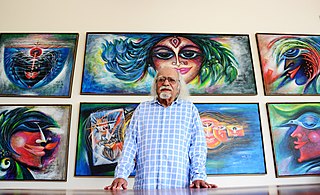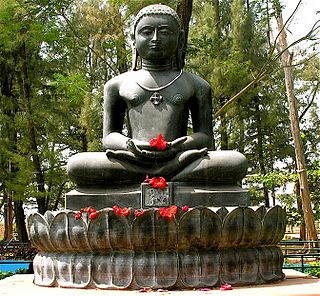Related Research Articles

Panaji is the capital of the Indian state of Goa and the headquarters of North Goa district. Previously, Panjim was the territorial capital of the entire Goa, Damaon& Diu. It lies on the banks of the Mandovi River estuary in the Tiswadi sub-district (taluka). With a population of 114,759 in the metropolitan area, Panaji is Goa's largest urban agglomeration, ahead of Margao and Mormugao.

The High Court of Bombay, also known as the Mumbai High Court, is the high court of the Indian states of Maharashtra and Goa, and the union territory of Dadra and Nagar Haveli and Daman and Diu. It is one of the oldest high courts in India. It is located in Mumbai, Maharashtra. The High Court has regional branches at Nagpur and Aurangabad in Maharashtra and Panaji, the capital of Goa.

Ponda, also known as Fondya, is a city and a municipal council in the north Goa district of Goa, India. Located in the central area of Goa, Ponda lies 28 km southeast of Panaji, the capital of Goa and 17 km northeast of Margao, the district headquarters. Ponda is also known as "Antruz Mahal" because of the presence of numerous famous temples and rich cultural heritage.

Mapusa is a town in North Goa, India. It is situated 13 km north of the capital Panaji. The town is the headquarters of Bardez Taluka. It is located on the main highway NH-17, linking Mumbai to Kochi.

Porvorim, also known as Parvari, is the De facto legislative and executive capital of the state of Goa, India, as both the Goa Legislative Assembly and Secretariat are functioning from the same complex in the region of Alto Porvorim in porvorim.(Alto - Portuguese word meaning high or upper). Soon it will also become the De facto judicial capital of Goa, when the High Court of Bombay at Goa which is currently functioning from Lyceum complex in Panaji, is transferred to the new building complex which is being constructed in Alto - Betim Porvorim region of Porvorim. The construction of the new building is expected to be completed by December 2020. Porvorim is situated on the right bank of the Mandovi River, as de jure capital of Goa, Panaji is located on the opposite bank. Porvorim is considered an upmarket residential hub as it lies on the Mumbai–Goa highway NH66. Goa's largest shopping centre - Mall De Goa - is situated here.

Vasco da Gama, often shortened to Vasco, is a city in the state of Goa on the west coast of India. It is named after the Portuguese explorer Vasco da Gama. It is the headquarters of the Mormugão taluka (subdistrict). The city lies on the western tip of the Mormugao peninsula, at the mouth of the Zuari River, about 30 kilometres (19 mi) from Panaji, Goa's capital, 28 kilometres (17 mi) from Margao, the district headquarters and about 5 kilometres (3.1 mi) from Dabolim Airport.
The Comunidades of Goa were a form of land association developed in Goa, India, where land-ownership was collectively held, but controlled by the male descendants of those who claimed to be the founders of the village, who in turn mostly belonged to upper caste groups. Documented by the Portuguese as of 1526, it was the predominant form of landholding in Goa prior to 1961. In form, it is similar to many other rural agricultural peoples' form of landholding, such as that of pre-Spanish Bolivia and the Puebloan peoples now in the Southwestern United States, identified by Karl Marx as the dualism of rural communities: the existence of collective land ownership together with private production on the land.

Media in Goa refers to the newspapers, magazines, radio stations, cable and television networks and online media in India's smallest state. Over the past two-and-half decades, the Goa-linked online media has also grown.

Goa University is a public higher education institution, headquartered in the city of Panaji, in the Indian state of Goa. In addition to Panaji, it has a campus in Margao, Mapusa, Ponda, Old Goa and Vasco da Gama.

The state of Goa, in India, is famous for its beaches and places of worship. Tourism is its primary industry, and is generally focused on the coastal areas of Goa, with decreased tourist activity inland.

The Annexation of Goa was the process in which the Republic of India annexed Estado da India, the then Portuguese Indian territories of Goa, Daman and Diu, starting with the armed action carried out by the Indian Armed Forces in December 1961. In India, this action is referred to as the "Liberation of Goa". In Portugal, it is referred to as the "Invasion of Goa".
St Inez creek is a creek in Panjim, in the Indian state of Goa. The creek opens up into the Mandovi River. The creek is 3.7 kilometres (2 mi) in length, with a surface area of 65,750 square metres (707,700 sq ft) with an average width of 12.6 metres (41 ft). The creek begins at the paddy fields at Altinho hill at Taleigao, Caranzalem, and the Nagahali hills of Dona Paula. Caculo Island, is located in the creek. The creek has 12 culverts that originate from the old Goa Medical College complex leading to the Campal head, the Fire Brigade, the sewerage treatment plant at Tonca, the Tambdi Mati Cumrabhat, and the El Passo hotel.

Tristão de Bragança Cunha, alternatively spelled as Tristao de Braganza Cunha, was a prominent Indian nationalist and anti-colonial activist from Goa. He is popularly known as the "Father of Goan nationalism", and was the organiser of the first movement to end Portuguese rule in Goa.

Goa State Museum, also known as the State Archaeology Museum, Panaji, is a museum in Goa, India. Established in 1977, it contains departments including Ancient History and Archaeology, Art and Craft, and Geology. The museum, as of 2008, had about 8,000 artifacts on display, including stone sculptures, wooden objects, carvings, bronzes, paintings, manuscripts, rare coins, and anthropological objects. Currently, the Museum is located at the Adil Shah's Palace in Panaji. The Museum's erstwhile premises at the EDC Complex in Patto, Panaji shall be demolished to make way for a new Museum building.

Goa is a state on the southwestern coast of India within the region known as the Konkan, and geographically separated from the Deccan highlands by the Western Ghats. It is surrounded by the Indian states of Maharashtra to the north and Karnataka to the east and south, with the Arabian Sea forming its western coast. It is India's smallest state by area and its fourth-smallest by population. Goa has the highest GDP per capita among all Indian states, two and a half times as high as the GDP per capita of the country as a whole. The Eleventh Finance Commission of India named Goa the best-placed state because of its infrastructure, and India’s National Commission on Population rated it as having the best quality of life in India. It is the third-highest ranking among Indian states in human development index.
The Directorate of Fire and Emergency Services, Goa is the fire brigade run by the Government of Goa.
The Goa Human Rights Commission was constituted in the month of March 2011 to perform the functions assigned to the State Commission under Chapter V of the Protection of Human Rights Act 1993. The current Chairman of the Commission is Justice Utkarsh V. Bakre, former High Court Judge.

Laxman Pai was an Indian artist and painter. He was a principal of the Goa College of Art, a post he held from 1977 to 1987. Pai was a recipient of several awards including India's third highest civilian honour of Padma Bhushan, awarded by the Government of India.

Jainism flourished in Goa during the rule of Kadamba dynasty. Broken sculptures of the Jain Tirthankara Suparshvanatha, belonging to the period of the Goan Kadamba ruler Shivachitta Permadi Dev, were discovered in an old Jain temple in Jainkot, Naroa.
References
- ↑ "About Altinho". HolidayIQ.com. Retrieved 23 August 2013.
- ↑ "Altinho Panaji, Goa". flickr.com. Retrieved 23 August 2013.